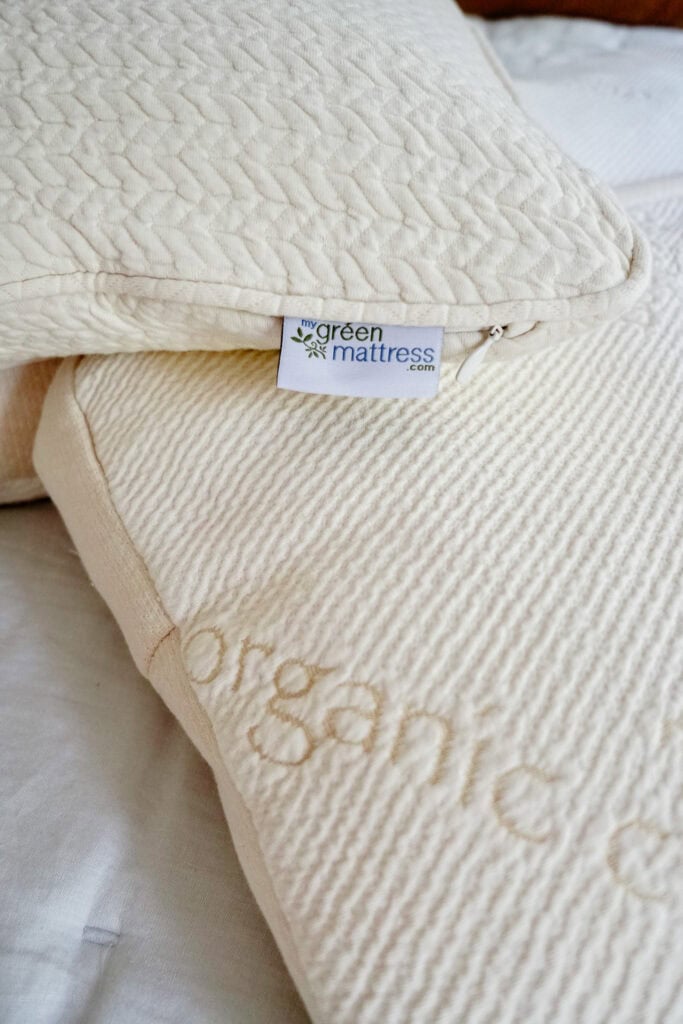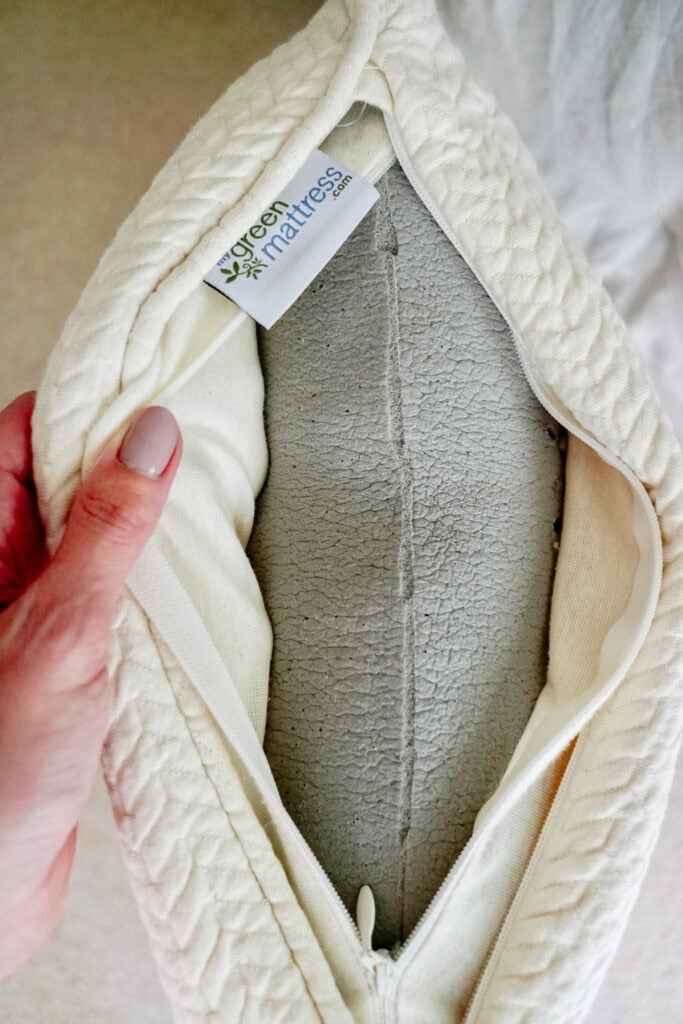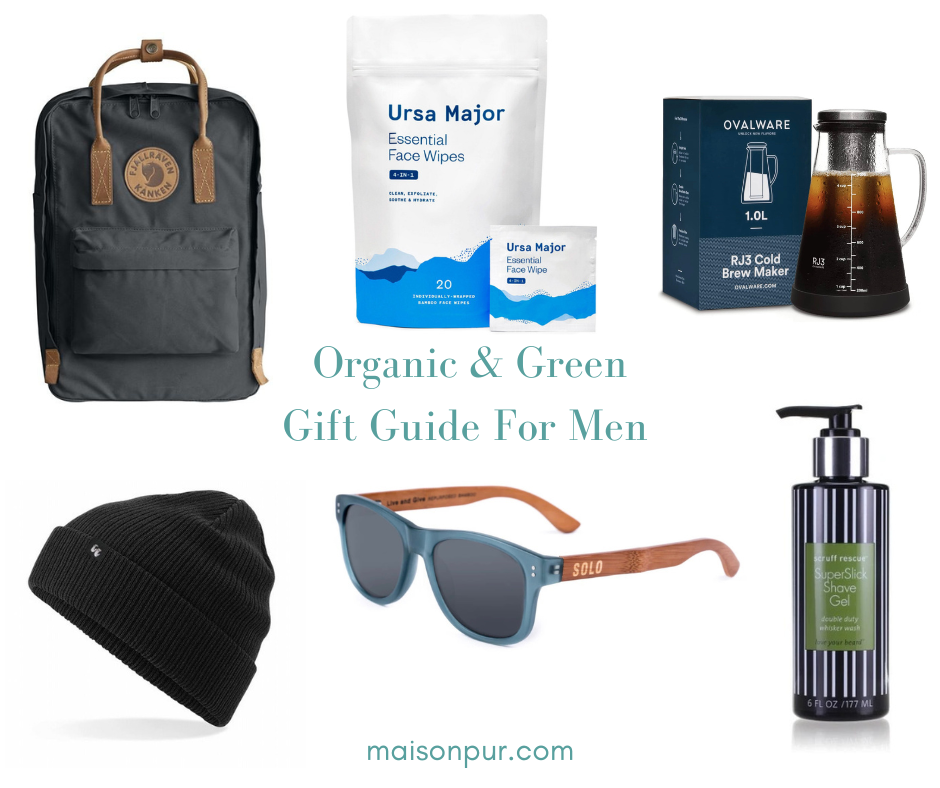Your Ultimate Organic Pillow Guide

In our quest for a healthier home, we often focus on the kitchen or cleaning products, but what about the one thing we spend a third of our lives with—our pillows? This organic pillow guide will walk you through the benefits of switching to organic pillows, what to look for, and share some of our favorite brands. By the end, you’ll be ready to make an informed choice for a restful, healthier sleep.

Your Ultimate Organic Pillow Guide
Why Choose Organic Pillows?
Reduced Toxin Exposure: Conventional pillows are often made from synthetic materials like polyester and treated with flame retardants, pesticides, and other chemicals. Organic pillows, however, use natural materials such as organic cotton, wool, and latex that are free from harmful additives. This means you’re limiting exposure to volatile organic compounds (VOCs) and other potentially harmful substances while you sleep.
Better for Allergy and Asthma Sufferers: Many organic materials are naturally hypoallergenic. Wool, for instance, resists dust mites and mold growth, making it a great choice for those with allergies or sensitivities. Wool also has natural antimicrobial and moisture-wicking properties, which help prevent the buildup of allergens and bacteria.

Key Features To Look For In Organic Pillows:
Non-Toxic Fillers:
The most common non-toxic fillers are organic cotton, wool, buckwheat, latex, and non-toxic PLA filler. All of these have a different feel, so depending on your personal preferences, you may opt for one over another. I’ll get into what has worked for us just a little further down.
Certified Organic and/or Non-Toxic Materials:
While most certifications aren’t perfect, they give a little more assurance that you’re buying a truly non-toxic product. Below is a breakdown of most of the certifications and what they mean. It’s a lot so skip it if you’re not trying to nerd out so hard on certifications, but I wanted to include the info because it can be confusing to figure out what they all mean!

1. GOTS (Global Organic Textile Standard)
- Ensures that textiles are truly organic and made in environmentally and socially responsible ways.
- Highlights:
- Requires at least 70% organic fibers.
- Prohibits toxic chemicals and GMOs.
- Sets strict labor standards, ensuring fair wages and safe working conditions.
2. OEKO-TEX Standard 100
- Tests for harmful substances in every component of the product, from threads to buttons.
- Highlights:
- Limits or bans certain chemicals, even if not yet legally regulated.
- Product classes for different levels of skin contact (Class I being safe for babies).
- Widely recognized and trusted in Europe and North America.
3. USDA Organic
- The official organic certification in the United States, primarily for agricultural products like cotton.
- Highlights:
- No synthetic pesticides, GMOs, or artificial fertilizers.
- Requires organic farming practices that promote biodiversity and soil health.
- Particularly relevant for organic cotton and wool used in textiles.
4. Fair Trade Certified
- Ensures fair wages, safe working conditions, and community investment for workers.
- Highlights:
- Focuses on ethical treatment of workers.
- Encourages sustainable practices and community development.
- Fair Trade products often come with a small premium that goes back to the workers’ communities.
5. Greenguard Gold Certification
- Tests for low emissions of volatile organic compounds (VOCs) to ensure indoor air quality.
- Highlights:
- Certifies products that are safe for sensitive indoor environments, like schools and healthcare facilities.
- Particularly relevant for products meant for children or those with chemical sensitivities.
- Ensures the product contributes to healthier indoor air quality.
6. MadeSafe Certified
- A certification focused on ensuring products are made without known toxic chemicals or ingredients.
- Highlights:
- Screens against a comprehensive list of harmful chemicals, including carcinogens, endocrine disruptors, and environmental toxins.
- Products are vetted for human health and ecosystem safety throughout their lifecycle.
- Ideal for those looking for non-toxic options in home goods, personal care, and bedding products.
Whew- Let’s get to the good stuff!
Our Favorite Non-Toxic and Organic Pillows:
After changing up our bedroom earlier this year and subsequently playing musical chairs (or musical beds?) in the kids’ rooms, we ended up buying several new pillows! You’ll see a few brands that we focused on because I really like their products and quality. We didn’t test any buckwheat pillows. Those have a unique feel and after trying them in the past, we found they weren’t for us.
Latex Pillows

My Green Mattress Charcoal Infused Latex Pillow: My son ended up with this one though I think he had to fight his dad for it! If you like very firm pillows, this is a good option. It’s a cooling and supportive pillow made from a solid core of charcoal-infused Dunlop latex. This molded pillow has a firm yet contouring feel that’s designed specifically for back and side sleepers (which is perfect for my son but ultimately wouldn’t work for my usually stomach-sleeping husband). Carson LOVES this pillow and that it’s cooling at night. $99-$109
Certifications
Eco-institute and FSC-certified Dunlop Latex
GOTS Certified Organic Cotton Cover
GOLS Certified Organic Dunlop Latex Core

Naturpedic Organic Adjustable Latex Pillow: This is filled with shredded latex and you can easily add or remove some to fill it to your liking (it even came with a little extra). I think this would work for more people than the one above, as it’s supportive but not quite as firm as the other latex option above. This won out as my husband’s favorite. Teddy removed some to make it flat enough for sleeping on his stomach but it’s still supportive for when he rolls to his side or back. $119-$159
Certifications
GOTS Certified Organic Cotton Cover
GOLS or FSC Certified Latex
Non-Latex Pillows
Naturepedic PLA Pillow: Their PLA filling is derived from non-GMO sugarcane and is MADESAFE certified. This ended up being my favorite because it’s soft and supportive without the slight bounce you get with latex. As a side sleeper, I wish it was filled just a little more but otherwise, it’s great. $69-$139
Certifications
MADESAFE certified
GOTS Certified Organic Cotton Cover

Parachute Home Down Alternative Body Pillow: While this isn’t organic, it is OEKO-TEX certified. This is the very best body pillow I’ve ever owned! It’s so fluffy and supportive, I can’t sleep without it. While a few organic pillow companies have body pillows, I’m partial to this shape and how much filling it has. $80
Certifications
OEKO-TEX Standard 100

Some Notable Mentions
While these didn’t make our favorites list, they’re great options that may work well for you!
Coyuchi Organic Molded Latex Pillow $148-168
Naturepedic Organic Side Sleeper $139
Avocado Luxury Organic Luxe Pillow $229-$249
Other Resources
If you are curious about other ways to create a healthier bedroom space, check out 5 Ways To Create A Non-Toxic Bedroom. I also have a guide to choosing non-toxic furniture!
Whether you prefer the softness of organic cotton, the breathability of wool, or the resilience of natural latex, there’s an organic pillow to suit your needs. With an organic pillow, you can rest easy knowing you’re creating a healthier sleeping space. Sweet dreams!
*Some affiliate links used. All thoughts and opinions are my own.







One Comment